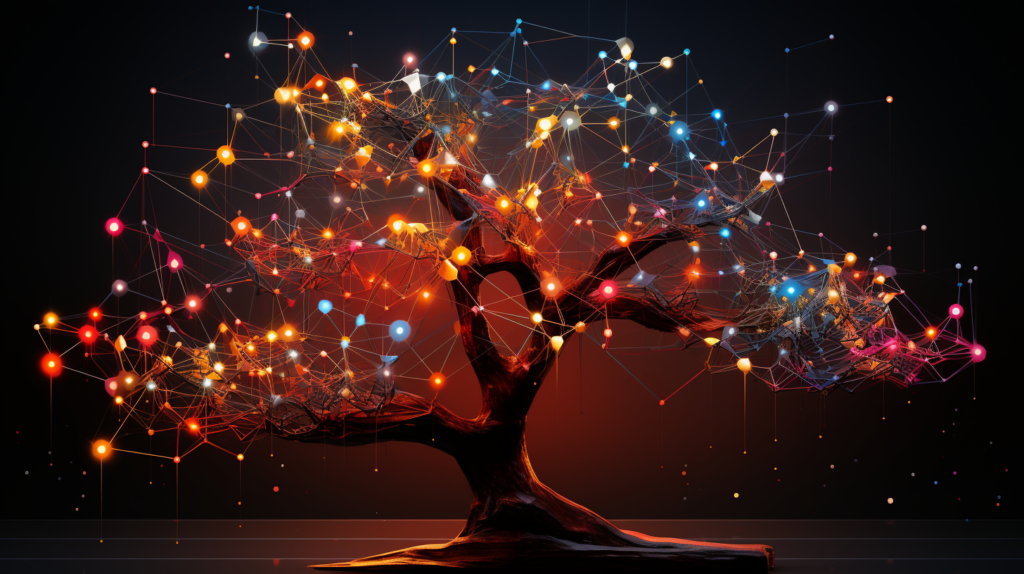Are you struggling to understand the difference between artificial intelligence (AI) and machine learning (ML)? It’s like trying to distinguish between two branches of the same tree. AI is the overarching field that encompasses ML, which is a subset focused on algorithms and statistical models. In this article, we will unravel their intricacies, explore their applications in various industries, and delve into the future possibilities of these groundbreaking technologies. Get ready to unlock the secrets behind AI and ML!
Key Takeaways
- Artificial intelligence (AI) is a field of computer science focused on creating systems that can perform tasks requiring human intelligence, while machine learning (ML) is a subset of AI that involves developing algorithms and models that enable computers to learn and make predictions without explicit programming.
- AI systems lack true understanding and consciousness, while ML algorithms learn from data patterns.
- AI applications include medical diagnostics, drug discovery, fraud detection, algorithmic trading, recommendation engines, and more, while ML applications include improved accuracy in medical diagnoses, predicting market trends, personalized advertisements, and revolutionizing various industries.
- Different techniques in ML include supervised learning, unsupervised learning, and reinforcement learning, which enable accurate predictions and decisions.
Table of Contents
The Definition of Artificial Intelligence

Artificial intelligence is a field of computer science that focuses on creating systems capable of performing tasks that would typically require human intelligence. However, it is important to understand the limitations of artificial intelligence and the ethical considerations associated with its development.
One major limitation of artificial intelligence lies in its ability to mimic human reasoning. While AI systems can process vast amounts of data and make decisions based on patterns, they lack true understanding and consciousness. This means that AI may not always be able to interpret complex situations or make nuanced judgments like humans can.
Another limitation is the potential for bias in AI algorithms. Since these algorithms are developed using historical data, they can inherit any biases present in that data, leading to unfair or discriminatory outcomes. It is crucial for developers to actively address these biases and ensure fairness in AI systems.
Ethical considerations also play a significant role in the development and deployment of artificial intelligence. Questions arise regarding privacy, accountability, and transparency. For example, how should personal information be handled by AI systems? Who should be held responsible if an AI system makes a harmful decision? These ethical dilemmas need careful consideration to ensure the responsible use of artificial intelligence.
Understanding Machine Learning

Machine Learning is a branch of Artificial Intelligence that focuses on the development of algorithms and models which enable computers to learn and make predictions without being explicitly programmed. It finds applications in various fields such as finance, healthcare, marketing, and e-commerce, where it can be used for tasks like fraud detection, personalized recommendations, and customer segmentation. The benefits of Machine Learning include improved accuracy in decision-making, increased efficiency in data analysis, and the ability to handle large amounts of complex data.
Definition of Machine Learning
The definition of machine learning is a field that focuses on developing algorithms to enable computers to learn from and make predictions or decisions based on data. In supervised learning, the algorithm is trained with labeled data, where each input has a corresponding output. The goal is for the algorithm to learn the relationship between the inputs and outputs so that it can accurately predict outputs for new inputs. On the other hand, unsupervised learning involves training the algorithm with unlabeled data. The objective in this case is for the algorithm to identify patterns, structures, or relationships within the data without any prior knowledge of what those patterns might be. Unsupervised learning allows for discovering hidden insights or clustering similar instances together based solely on their inherent properties. Both supervised and unsupervised learning techniques play vital roles in machine learning by enabling computers to learn from and analyze vast amounts of data efficiently and effectively.
Applications of Machine Learning
You can utilize machine learning algorithms in various industries and fields, such as healthcare, finance, and marketing. Machine learning has a wide range of real-world applications that have a significant impact on society. In healthcare, machine learning algorithms can be used to analyze medical data and improve the accuracy of diagnoses. This can lead to more effective treatments and better patient outcomes. In finance, machine learning models can be employed to predict market trends, detect fraudulent activities, and optimize investment strategies. This enables financial institutions to make informed decisions and mitigate risks. In marketing, machine learning techniques allow businesses to personalize advertisements based on consumer preferences and behavior patterns. This not only enhances customer satisfaction but also increases sales revenue. Overall, the application of machine learning is revolutionizing various industries and positively influencing society’s progress.
Benefits of Machine Learning
By implementing machine learning algorithms, you can improve decision-making processes and achieve more accurate results. Machine learning has several benefits that make it a valuable tool in various industries:
- Increased efficiency: Machine learning algorithms can analyze large amounts of data quickly, allowing for faster and more efficient decision-making.
- Improved accuracy: By using historical data and patterns, machine learning models can make predictions with high accuracy rates.
- Cost savings: Automating certain tasks through machine learning can reduce the need for manual labor, leading to cost savings for businesses.
- Personalization: Machine learning enables personalized experiences by analyzing user behavior and preferences.
However, there are challenges in implementing machine learning. These include the need for quality data, model interpretability, and potential bias in algorithmic decision-making. Ethical considerations also arise when using machine learning, such as privacy concerns and fairness issues. It is important to address these challenges and ethical considerations to ensure responsible use of machine learning technology.
Key Differences Between AI and ML

When discussing the key differences between AI and ML, it is important to understand their basics and application differences. AI, or artificial intelligence, refers to the broader concept of machines performing tasks that would typically require human intelligence. On the other hand, ML, or machine learning, is a subset of AI that focuses on algorithms allowing computers to learn from data and make predictions or decisions without being explicitly programmed. Understanding these fundamental distinctions will help you grasp how AI and ML are applied in various fields and industries.
AI Vs ML Basics
Artificial intelligence and machine learning are often confused, but they have distinct differences in their basic principles. To help you understand these differences, let’s break down the basics of AI and ML:
- AI vs ML comparison: AI is a broader field that encompasses the development of intelligent systems capable of performing tasks that typically require human intelligence. On the other hand, ML focuses on creating algorithms that allow machines to learn from data and make predictions or decisions without explicit programming.
- AI algorithms: AI algorithms are designed to replicate human-like decision-making processes by using rules-based systems or expert systems. These algorithms rely on predefined rules and knowledge bases to process information and generate intelligent outputs.
- ML algorithms: ML algorithms, on the other hand, enable machines to learn from data patterns without explicitly being programmed. They use statistical techniques to identify patterns, make predictions, or classify new data based on previous examples.
Application Differences
Now that you understand the basics of AI and ML, let’s dive into their application differences. When it comes to data mining, AI and ML both play crucial roles. Data mining involves extracting valuable insights from large datasets, and AI algorithms can be used to identify patterns and trends within this data. On the other hand, ML techniques are specifically designed for data mining tasks such as classification or clustering.
Another significant application difference lies in natural language processing (NLP). NLP is a field of AI that focuses on enabling computers to understand and interpret human language. While AI encompasses NLP as one of its components, ML techniques are often employed to train models for specific NLP tasks like sentiment analysis or text summarization.
Understanding these application differences helps us see that while both AI and ML contribute to data mining and natural language processing, they each have distinct approaches and areas of expertise.
AI Applications and Use Cases

If you want to understand AI applications and use cases, you should explore the various industries where it is being implemented. AI is revolutionizing numerous sectors, providing solutions to complex problems and improving efficiency. Here are some real-world use cases of AI applications:
- Healthcare: AI is being used in medical diagnostics, drug discovery, and personalized medicine. It can analyze medical images with high accuracy, assist in surgical procedures, and monitor patient health remotely.
- Finance: AI algorithms are powering fraud detection systems, algorithmic trading platforms, and customer service chatbots. They help identify patterns in financial data, make predictions for investment decisions, and automate routine tasks.
- Manufacturing: AI enables predictive maintenance by analyzing sensor data to detect equipment failures before they occur. It also optimizes production processes by identifying bottlenecks and recommending improvements.
- Retail: AI powers recommendation engines that suggest products based on customer preferences and purchase history. It also enables inventory management optimization and demand forecasting.
These examples demonstrate the wide range of applications for AI across industries. As technology advances further, we can expect even more innovative use cases that will transform how businesses operate.
ML Algorithms and Techniques
To understand ML algorithms and techniques, you should explore the different approaches used in training models and making predictions. ML algorithms are at the core of machine learning, enabling computers to learn from data and make accurate predictions or decisions without being explicitly programmed. These algorithms can be categorized into three main types: supervised learning, unsupervised learning, and reinforcement learning.
Supervised learning algorithms require labeled examples to train a model. The algorithm learns from these labeled examples to make predictions on new, unseen data. Common supervised learning techniques include linear regression, decision trees, support vector machines (SVM), and neural networks.
Unsupervised learning algorithms, on the other hand, do not require labeled data for training. Instead, they aim to find patterns or structures within unlabeled datasets. Clustering and dimensionality reduction are popular unsupervised learning techniques used for tasks like customer segmentation or anomaly detection.
Reinforcement learning is a type of machine learning where an agent learns through trial and error by interacting with an environment. The goal is for the agent to maximize its cumulative reward over time by making optimal decisions based on past experiences.
The Role of Data in AI and ML

You need to understand that data plays a crucial role in AI and ML as it is the foundation for training models and making accurate predictions. The quality and quantity of data directly impact the performance and effectiveness of AI algorithms. Here are some key points to consider regarding the role of data in AI:
- Training: Data is used to train machine learning models by feeding it with labeled examples or patterns. This allows the model to learn and make predictions based on new, unseen inputs.
- Accuracy: The more diverse and representative the data, the better accuracy an AI model can achieve. Adequate representation of all possible scenarios helps avoid bias and increase reliability.
- Challenges: Collecting high-quality data can be challenging due to various factors such as cost, privacy concerns, accessibility, and time constraints. Additionally, unstructured or incomplete data may require preprocessing before being used effectively.
- Data Management: Proper organization, storage, and retrieval of large volumes of data are essential for efficient AI systems. Tools like databases, cloud storage, and distributed computing play a crucial role in managing vast amounts of information.
AI and ML in Business and Industry

Incorporating AI and ML technologies into your business operations can enhance efficiency, streamline processes, and improve decision-making. The applications of AI and ML in various industries have revolutionized the way businesses operate. In healthcare, AI and ML algorithms are being used to analyze large volumes of patient data to identify patterns and make accurate diagnoses. This has led to improved patient outcomes and reduced medical errors. Similarly, in finance, AI-powered chatbots are assisting customers with their queries, while ML algorithms are analyzing market trends to provide personalized investment advice.
AI and ML technologies have also enabled businesses to automate repetitive tasks, such as data entry or inventory management. This not only saves time but also reduces the chances of human error. Moreover, by using predictive analytics models built on AI and ML algorithms, businesses can anticipate customer needs and preferences more accurately.
However, it is essential for businesses to understand that successful implementation of AI and ML requires a robust infrastructure capable of handling large amounts of data efficiently. Additionally, adequate cybersecurity measures must be in place to protect sensitive information from potential threats.
The Future of AI and ML

In the previous subtopic, we discussed the integration of AI and ML in business and industry. Now let’s delve into the future of these technologies and their impact on various aspects of our lives.
The rapid advancement of AI and ML has significant implications for the job market. As these technologies continue to evolve, they have the potential to automate repetitive tasks, leading to a transformation in workforce dynamics. Here are some key points to consider:
- Job displacement: Automation may lead to certain jobs becoming obsolete or significantly reduced in demand.
- Emerging job roles: On the other hand, new opportunities will arise as businesses adapt to this technology-driven landscape.
- Reskilling requirements: With changing job requirements, individuals will need to acquire new skills that align with emerging roles.
- Ethical considerations: The use of AI and ML raises ethical concerns around privacy, bias, transparency, and accountability.
While there is no doubt that AI and ML will revolutionize industries and reshape our work environment, it is crucial to address ethical considerations associated with their applications. Striking a balance between innovation and responsible use is essential for a sustainable future.
As we move forward into this era of technological progress, understanding the impact on job markets and upholding ethical standards will be paramount. It is essential for organizations, policymakers, and individuals alike to proactively navigate these challenges while embracing the benefits brought by AI and ML advancements.
Frequently Asked Questions
How Can Artificial Intelligence and Machine Learning Benefit the Healthcare Industry?
Artificial intelligence and machine learning can revolutionize the healthcare industry. By analyzing vast amounts of data, they can assist in diagnosing diseases, predicting patient outcomes, and developing treatments for medical advancements.
What Are the Ethical Considerations Surrounding the Use of Artificial Intelligence and Machine Learning?
When considering the ethical implications of artificial intelligence and machine learning, it is crucial to examine privacy concerns, potential biases, and ensuring fairness in decision-making processes. These factors must be carefully addressed to ensure responsible use of these technologies.
Are There Any Limitations or Challenges to Implementing Artificial Intelligence and Machine Learning in Real-World Scenarios?
Implementing AI and ML in real-world scenarios presents challenges and limitations. You must navigate data quality issues, algorithm biases, and resource requirements. Overcoming these hurdles is essential for successful integration and achieving the desired outcomes.
How Can Artificial Intelligence and Machine Learning Be Used to Enhance Cybersecurity?
Using AI and ML can enhance cybersecurity by detecting and preventing fraud, as well as enhancing network security. AI analyzes patterns and anomalies, while ML improves accuracy over time. Embrace these technologies to strengthen your defenses.
What Are Some Examples of Successful Applications of Artificial Intelligence and Machine Learning in the Field of Finance?
Successful applications of AI and ML in finance include algorithmic trading, fraud detection, risk assessment, and customer profiling. AI analyzes vast amounts of data to make predictions and automate processes, while ML improves accuracy over time.
Conclusion
So, there you have it. After delving into the intricate world of artificial intelligence and machine learning, it’s clear that they are definitely not the same. While AI encompasses a broader concept of creating intelligent machines, ML is a subset that focuses on training these machines to learn from data. The distinctions between the two are crucial in understanding their applications and implications in various industries. As we continue to witness advancements in technology, it’s exciting to ponder the future of AI and ML and how they will shape our world. It’s safe to say that these technologies will play an increasingly vital role in business and industry, revolutionizing processes and transforming the way we live and work. So buckle up for this thrilling journey into the realm of AI and ML!
